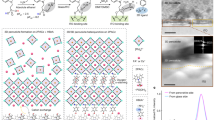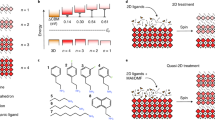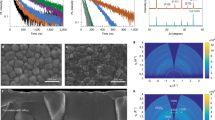Abstract
The main bottlenecks limiting the photovoltaic performance and stability of inverted perovskite solar cells (PSCs) are trap-assisted non-radiative recombination losses and photochemical degradation at the interface between perovskite and charge-transport layers. We propose a strategy to manipulate the crystallization of methylammonium-free perovskite by incorporating a small amount of 2-aminoindan hydrochloride into the precursor inks. This additive also modulates carrier recombination and extraction dynamics at the buried interface via the formation of a bottom-up two-dimensional/three-dimensional heterojunction. The resultant inverted PSC achieves a power conversion efficiency of 25.12% (certified 24.6%) at laboratory scale (0.09 cm2) and 22.48% at a larger area (1 cm2) with negligible hysteresis. More importantly, the resulting unencapsulated devices show superior operational stability, maintaining >98% of their initial efficiency of >24% after 1,500 hours of continuous maximum power point tracking under simulated AM1.5 illumination. Meanwhile, the encapsulated devices retain >92% of initial performance for 1,200 hours under the damp-heat test (85 °C and 85% relative humidity).
This is a preview of subscription content, access via your institution
Access options
Access Nature and 54 other Nature Portfolio journals
Get Nature+, our best-value online-access subscription
$29.99 / 30 days
cancel any time
Subscribe to this journal
Receive 12 digital issues and online access to articles
$119.00 per year
only $9.92 per issue
Buy this article
- Purchase on Springer Link
- Instant access to full article PDF
Prices may be subject to local taxes which are calculated during checkout



Similar content being viewed by others
Data availability
All data generated or analysed during this study are included in the published article and its Supplementary Information and Source Data files. The data that support the plots within this paper and other findings of this study are available from the corresponding authors upon reasonable request. Source data are provided with this paper.
References
Al-Ashouri, A. et al. Monolithic perovskite/silicon tandem solar cell with >29% efficiency by enhanced hole extraction. Science 370, 1300–1309 (2020).
Li, B. & Zhang, W. Improving the stability of inverted perovskite solar cells towards commercialization. Commun. Mater. 3, 65 (2022).
Zhang, H. et al. Toward all room-temperature, solution-processed, high-performance planar perovskite solar cells: a new scheme of pyridine-promoted perovskite formation. Adv. Mater. 29, 1604695 (2017).
Li, X. et al. Constructing heterojunctions by surface sulfidation for efficient inverted perovskite solar cells. Science 375, 434–437 (2022).
Cao, Q. et al. Efficient and stable inverted perovskite solar cells with very high fill factors via incorporation of star-shaped polymer. Sci. Adv. 7, eabg0633 (2021).
Chen, H. et al. Quantum-size-tuned heterostructures enable efficient and stable inverted perovskite solar cells. Nat. Photonics 16, 352–358 (2022).
Azmi, R. et al. Damp heat-stable perovskite solar cells with tailored-dimensionality 2D/3D heterojunctions. Science 376, 73–77 (2022).
Li, Z. et al. Organometallic-functionalized interfaces for highly efficient inverted perovskite solar cells. Science 376, 416–420 (2022).
Chen, R. et al. Robust hole transport material with interface anchors enhances the efficiency and stability of inverted formamidinium–cesium perovskite solar cells with a certified efficiency of 22.3%. Energy Environ. Sci. 15, 2567–2580 (2022).
Xie, F. et al. Vertical recrystallization for highly efficient and stable formamidinium-based inverted-structure perovskite solar cells. Energy Environ. Sci. 10, 1942–1949 (2017).
Zheng, X. et al. Managing grains and interfaces via ligand anchoring enables 22.3%-efficiency inverted perovskite solar cells. Nat. Energy 5, 131–140 (2020).
Jiang, Q. et al. Surface reaction for efficient and stable inverted perovskite solar cells. Nature 611, 278–283 (2022).
Wu, Y. et al. Perovskite solar cells with 18.21% efficiency and area over 1 cm2 fabricated by heterojunction engineering. Nat. Energy 1, 16148 (2016).
Li, F. et al. Regulating surface termination for efficient inverted perovskite solar cells with greater than 23% efficiency. J. Am. Chem. Soc. 142, 20134–20142 (2020).
Degani, M. et al. 23.7% efficient inverted perovskite solar cells by dual interfacial modification. Sci. Adv. 7, eabj7930 (2021).
Chen, S. et al. Stabilizing perovskite-substrate interfaces for high-performance perovskite modules. Science 373, 902–907 (2021).
Jeon, N. J. et al. Compositional engineering of perovskite materials for high-performance solar cells. Nature 517, 476–480 (2015).
Yoo, J. J. et al. Efficient perovskite solar cells via improved carrier management. Nature 590, 587–593 (2021).
Juarez, P. et al. Thermal degradation of CH3NH3PbI3 perovskite into NH3 and CH3I gases observed by coupled thermogravimetry–mass spectrometry analysis. Energy Environ. Sci. 9, 3406–3410 (2016).
Peña-Camargo, F. et al. Halide segregation versus interfacial recombination in bromide-rich wide-gap perovskite solar cells. ACS Energy Lett. 5, 2728–2736 (2020).
Liang, J. et al. Suppressing the phase segregation with potassium for highly efficient and photostable inverted wide-band gap halide perovskite solar cells. ACS Appl. Mater. Interfaces 12, 48458–48466 (2020).
Balakrishna, R. G. et al. Mixed halide perovskite solar cells. Consequence of iodide treatment on phase segregation recovery. ACS Energy Lett. 3, 2267–2272 (2018).
Tang, X. et al. Local observation of phase segregation in mixed-halide perovskite. Nano Lett. 18, 2172–2178 (2018).
Knight, A. J. et al. Electronic traps and phase segregation in lead mixed-halide perovskite. ACS Energy Lett. 4, 75–84 (2019).
Brennan, M. C. et al. Light-induced anion phase segregation in mixed halide perovskites. ACS Energy Lett. 3, 204–213 (2018).
Turren-Cruz, S.-H. et al. Methylammonium-free, high-performance, and stable perovskite solar cells on a planar architecture. Science 362, 449–453 (2018).
Lee, J.-W. et al. Formamidinium and cesium hybridization for photo- and moisture-stable perovskite solar cell. Adv. Energy Mater. 5, 1501310 (2015).
Yi, C. et al. Entropic stabilization of mixed A-cation ABX3 metal halide perovskites for high performance perovskite solar cells. Energy Environ. Sci. 9, 656–662 (2016).
Liu, B. et al. Interfacial defect passivation and stress release via multi-active-site ligand anchoring enables efficient and stable methylammonium-free perovskite solar cells. ACS Energy Lett. 6, 2526–2538 (2021).
Kim, G. et al. Impact of strain relaxation on performance of α-formamidinium lead iodide perovskite solar cells. Science 370, 108–112 (2020).
Chen, J. et al. Materials and methods for interface engineering toward stable and efficient perovskite solar cells. ACS Energy Lett. 5, 2742–2786 (2020).
Ni, Z. et al. Resolving spatial and energetic distributions of trap states in metal halide perovskite solar cells. Science 367, 1352–1358 (2020).
Boyd, C. C. et al. Overcoming redox reactions at perovskite-nickel oxide interfaces to boost voltages in perovskite solar cells. Joule 4, 1759–1775 (2020).
Zhang, J. et al. Elimination of interfacial lattice mismatch and detrimental reaction by self-assembled layer dual-passivation for efficient and stable inverted perovskite solar cells. Adv. Energy Mater. 12, 2103674 (2022).
Wang, S. et al. Critical role of removing impurities in nickel oxide on high-efficiency and long-term stability of inverted perovskite solar cells. Angew. Chem. Int. Ed. 61, e202116534 (2022).
Chen, W. et al. Molecule-doped nickel oxide: verified charge transfer and planar inverted mixed cation perovskite solar cell. Adv. Mater. 30, e1800515 (2018).
Hu, S. et al. Optimized carrier extraction at interfaces for 23.6% efficient tin–lead perovskite solar cells. Energy Environ. Sci. 15, 2096–2107 (2022).
Hempel, H. et al. Predicting solar cell performance from terahertz and microwave spectroscopy. Adv. Energy Mater. 12, 2102776 (2022).
Savenije, T. et al. Quantifying charge-carrier mobilities and recombination rates in metal halide perovskites from time-resolved microwave photoconductivity measurements. Adv. Energy Mater. 10, 1903788 (2020).
Hutter, E. M. et al. Charge transfer from methylammonium lead iodide perovskite to organic transport materials: efficiencies, transfer rates, and interfacial recombination. Adv. Energy Mater. 7, 1602349 (2017).
Labram, J. G. et al. Recombination at high carrier density in methylammonium lead iodide studied using time-resolved microwave conductivity. J. Appl. Phys. 122, 065501 (2017).
Zhou, J. et al. Cryogenic focused ion beam enables atomic-resolution imaging of local structures in highly sensitive bulk crystals and devices. J. Am. Chem. Soc. 144, 3182–3191 (2022).
Kirchartz, T. et al. Photoluminescence-based characterization of halide perovskites for photovoltaics. Adv. Energy Mater. 10, 1904134 (2020).
Baloch, A. A. B. et al. Analysis of photocarrier dynamics at interfaces in perovskite solar cells by time-resolved photoluminescence. J. Phys. Chem. C 122, 26805–26815 (2018).
Krogmeier, B. et al. Quantitative analysis of the transient photoluminescence of CH3NH3PbI3/PC61BM heterojunctions by numerical simulations. Sustain. Energy Fuels 2, 1027–1034 (2018).
Xue, J. et al. Reconfiguring the band-edge states of photovoltaic perovskites by conjugated organic cations. Science 371, 636–640 (2021).
Price, M. B. et al. Hot-carrier cooling and photoinduced refractive index changes in organic–inorganic lead halide perovskites. Nat. Commun. 6, 8420 (2015).
Chen, X. et al. Tuning spin-polarized lifetime in two-dimensional metal–halide perovskite through exciton binding energy. J. Am. Chem. Soc. 143, 19438–19445 (2021).
Chen, J. et al. Simultaneous improvement of photovoltaic performance and stability by in situ formation of 2D perovskite at (FAPbI3)0.88(CsPbBr3)0.12/CuSCN interface. Adv. Energy Mater. 8, 1702714 (2018).
Khenkin, M. V. et al. Consensus statement for stability assessment and reporting for perovskite photovoltaics based on ISOS procedures. Nat. Energy 5, 35–49 (2020).
Zhang, H. et al. Pinhole-free and surface-nanostructured NiOx film by room-temperature solution process for high-performance flexible perovskite solar cells with good stability and reproducibility. ACS Nano 10, 1503–1511 (2016).
Kuhne, T. D. et al. CP2K: an electronic structure and molecular dynamics software package–quickstep: efficient and accurate electronic structure calculations. J. Chem. Phys. 152, 194103 (2020).
Lu, T. et al. Multiwfn: a multifunctional wavefunction analyzer. J. Comput. Chem. 33, 580–592 (2012).
VandeVondele, J. et al. Gaussian basis sets for accurate calculations on molecular systems in gas and condensed phases. J. Chem. Phys. 127, 114105 (2007).
Li, M. et al. Stabilizing perovskite precursor by synergy of functional groups for NiOx-based inverted solar cells with 23.5% efficiency. Angew. Chem. Int. Ed. 61, e202206914 (2022).
Acknowledgements
Z.Z. acknowledges funding from the Defense Industrial Technology Development Program (JCKY2017110C0654), Fundamental Research Fund for the Central Universities (2022CDJQY-010) and National Natural Science Foundation of China (grant nos. 11974063 and 61904023). J. Chen acknowledges funding from Support Plan for Overseas Students to Return to China for Entrepreneurship and Innovation (grant no. cx2020003), the Fundamental Research Funds for the Central Universities (grant no. 2020CDJ-LHZZ-074) and Natural Science Foundation of Chongqing (grant no. cstc2020jcyj-msxmX0629). H.Z. acknowledges the funding from Shanghai Pujiang Program (22PJ1401200). M.G. acknowledges funding from the European Union’s Horizon 2020 research and innovation programme GRAPHENE Flagship Core 3 grant agreement no. 881603. X.L. acknowledges the Research Fund of the State Key Laboratory of Solidification Processing (NPU) (grant no. 2021-QZ-02) and the Fundamental Research Funds for the Central Universities (3102019JC005).
Author information
Authors and Affiliations
Contributions
H.L., J. Chen and Z.Z. conceived the project. H.L., C.Z., C.G. and Q.Z. prepared the samples and devices, and performed all other measurement except for TEM, TRS, GIWAXS and time-resolved microwave conductivity measurements. D.Z., J.L. and J.Z. performed TEM measurements. X.Y., S.G. and X.C. conducted TRS measurements. H.Y. carried out GIWAXS measurements. Q.L. performed time-resolved microwave conductivity measurements. H.Z. and J. Chen wrote the first draft of the manuscript. H.L. and R.L. certified the efficiency of the PSCs. J.Y. and X.L. conducted the long-term operational stability measurements. M.G. was involved in the data analysis and wrote the final version of the manuscript. H.Z., X.L., M.G., J. Chen and Z.Z. supervised this project. All authors analysed the data and contributed to the discussions.
Corresponding authors
Ethics declarations
Competing interests
The authors declare no competing interests.
Peer review
Peer review information
Nature Energy thanks Eline Hutter, Atsushi Wakamiya, Christian Wolff and the other, anonymous, reviewer(s) for their contribution to the peer review of this work.
Additional information
Publisher’s note Springer Nature remains neutral with regard to jurisdictional claims in published maps and institutional affiliations.
Supplementary information
Supplementary Information
Supplementary Figs. 1–30, Notes 1 and 2 and Tables 1–4.
Supplementary Data 1
The individual raw data for Supplementary Fig. 19 and Supplementary Table 2.
Source data
Source Data Fig. 3
The source data for Fig. 3a,f.
Rights and permissions
Springer Nature or its licensor (e.g. a society or other partner) holds exclusive rights to this article under a publishing agreement with the author(s) or other rightsholder(s); author self-archiving of the accepted manuscript version of this article is solely governed by the terms of such publishing agreement and applicable law.
About this article
Cite this article
Li, H., Zhang, C., Gong, C. et al. 2D/3D heterojunction engineering at the buried interface towards high-performance inverted methylammonium-free perovskite solar cells. Nat Energy 8, 946–955 (2023). https://doi.org/10.1038/s41560-023-01295-8
Received:
Accepted:
Published:
Issue Date:
DOI: https://doi.org/10.1038/s41560-023-01295-8
This article is cited by
-
Harnessing strong aromatic conjugation in low-dimensional perovskite heterojunctions for high-performance photovoltaic devices
Nature Communications (2024)
-
Defect passivation in methylammonium/bromine free inverted perovskite solar cells using charge-modulated molecular bonding
Nature Communications (2024)
-
Double-side 2D/3D heterojunctions for inverted perovskite solar cells
Nature (2024)
-
Enhanced nonlinear optical and optical liming properties of holmium containing borate glasses embedded with silver nanoparticles
Journal of Materials Science: Materials in Electronics (2024)
-
Regulating depletion region enables highly efficient and stable perovskite solar cells
Science China Chemistry (2024)



